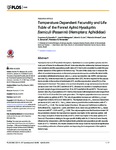Please use this identifier to cite or link to this item:
http://www.alice.cnptia.embrapa.br/alice/handle/doc/1041166| Title: | Temperature-dependent fecundity and life table of the fennel aphid hyadaphis foeniculi (Passerini) (Hemiptera: Aphididae). |
| Authors: | RAMALHO, F. de S.  MALAQUIAS, J. B.   LIRA, A. C. S.   OLIVEIRA, F. Q.   ZANUNCIO, J. C.   FERNANDES, F. S.   |
| Affiliation: | FRANCISCO DE SOUZA RAMALHO, CNPA; JOSE BRUNO MALAQUIAS, CNPA; ALINE CRISTINA SILVA LIRA, DOUTORANDA - UFRPE; FLÁVIA Q. OLIVEIRA, UNESP; JOSÉ COLA ZANUNCIO, UFV; FRANCISCO SALES FERNANDES, USP/ESALQ. |
| Date Issued: | 2015 |
| Citation: | Plos One, v. 10, n. 4, Apr. 2015. |
| Description: | Hyadaphis foeniculi (Passerini) (Hemiptera: Aphididae) is a cosmopolitan species and the main pest of fennel in northeastern Brazil. Understanding the relationship between temperature variations and the population growth rates of H. foeniculi is essential to predict the population dynamics of this aphid in the fennel crop. The aim of this study was to measure the effect of constant temperature on the adult prereproductive period and the life table fertility parameters (infinitesimal increase ratio (rm), gross reproduction rate (GRR), net reproduction rate (R0), finite increase ratio (?), generation time (GT), the time required for the population to double in the number of individuals (DT), and the reproduction value (RVx)) of the fennel pest H. foeniculi. The values of lx (survival of nymphs at age x) increased as the temperature rose from 15 to 28°C and fell at 30°C, whereas mx (number of nymphs produced by each nymph of age x) increased from 15 to 25°C and fell at 28 and 30°C. The net reproduction rates (R0) of populations of H. foeniculi increased with temperature and ranged from 1.9 at 15°C to 12.23 at 28°C for each generation. The highest population increase occurred with the apterous aphids at 28°C. The rate of population increase per unit time (rm) (day) ranged from 0.0033 (15°C) to 0.1995 (28°C). The highest values of rm were recorded at temperatures of 28°C and 30°C. The rm values were a good fit to the models tested, with R2 > 0.91 and R2 adj > 0.88. The models tested (Davidson, Sharpe and DeMichele modified by Schoolfield et al., Logan et al., Lamb, and Briere et al.) were very good fits for the rm values observed, with R2 > 0.91 and R2 adj > 0.88. The only exception was the Davidson model. Of the parameters studied, the reproductive capacity was higher in the apterous aphids, with the unique exception of daily fecundity at 28°C, which was higher in the alate aphids of H. foeniculi. Parameters relating to the age-specific fertility table for H. foeniculi were heavily influenced by temperature, with the highest biotic potential and population growth capacity found at 34°C. Therefore, the results obtained in this study could be of practical significance for predicting outbreaks of fennel aphids and improving the management of this aphid in fennel crops. |
| Keywords: | Hemiptera aphididae Hyadaphis foeniculi Aphid |
| Type of Material: | Artigo de periódico |
| Access: | openAccess |
| Appears in Collections: | Artigo em periódico indexado (CNPA)  |
Files in This Item:
| File | Description | Size | Format | |
|---|---|---|---|---|
| Temperaturedependentfecundityandlifetable....pdf | 2,62 MB | Adobe PDF |  View/Open |









